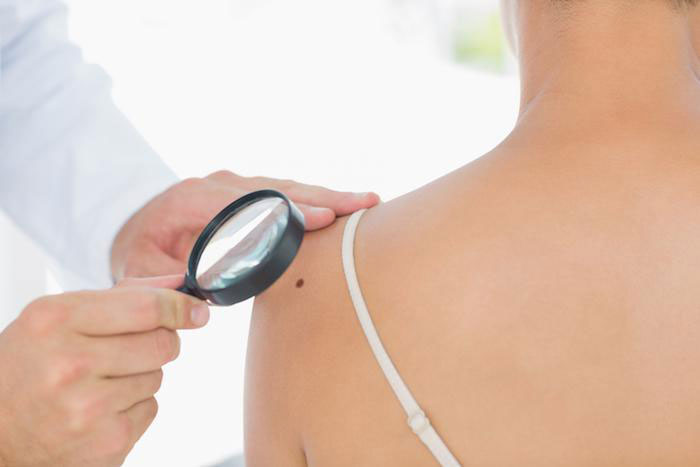Cancer involves healthy cells that change their structure and begin to grow in abnormal patterns. Skin cancer, the most common type of cancer, attacks more than 9,500 Americans every day, but only accounts for less than 1% of all cancer deaths. That’s because when caught early, skin cancer is highly treatable.
Catching it early and getting rid of it is our specialty here at Kentucky Skin Cancer Center in Bowling Green and Franklin, Kentucky. We offer comprehensive skin cancer screening to monitor your skin health and detect the signs even before you can see them yourself. There are four main types of skin cancer and the symptoms for which you need to be on the lookout.
Basal cell carcinoma
About 80% of all skin cancer falls into the category of basal cell carcinoma (BCC), and about 4 million Americans get it every year. Basal cells are spherical and live in the lowest part of your skin’s upper layer, the epidermis. The good news about BCC is that it typically doesn’t spread to other areas. It can appear anywhere on your body, but the most common places are on the head and neck. Radiation, whether from cancer treatment or the sun, is the main cause of altered basal cells that turn into cancer.
Spotting BCC can be tricky, because it comes in many forms and looks different on every individual. Here are some common symptoms:
- Pink or red patch
- Open sore that won’t heal
- Scar-like tissue, flat, yellow or white
- Shiny bump
- Pink growth with slightly raised edges
- Growth with indented center
Sometimes, BCCs can bleed or ooze and crust over. The longer you wait to have your BCC treated, the more damage it does and the more likely it is to come back even after treatment. Although that damage is usually localized, in rare cases it can spread to other areas and may become life-threatening.
Squamous cell carcinoma
Squamous cells also live in your epidermis, but these are flat rather than round and only account for about 20% of skin cancer cases. We typically find squamous cell carcinomas (SCC) in places where your skin has been burned, damaged by chemicals, or exposed to X-rays, as these things trigger changes in your cells. The mouth and lips are common sites, but so are the anus and vagina. SCCs are more likely to spread than BCCs, but only in about 5% of the cases.
Signs of SCC include:
- Rough, thickened skin
- Wart-like growths
- Red, scaly patches
- Open sores
- Raised patches with a divot in the center
Like BCCs, SCCs can bleed, ooze, and crust over. Also like BCCs, squamous cell carcinomas can spread if you ignore them and cause serious damage to your skin.
Melanoma
Another type of cell that makes up the epidermis, called melanocytes, produce the pigment (melanin) that gives your skin and hair its color. When you get tanned or sunburned, what you’re really seeing is the result of your melanin rapidly increasing to protect your skin.
Unfortunately, the damage has already been done, and if it affected the DNA in your cells, it may lead to melanoma, a type of skin cancer that spreads rapidly and is dangerous and fatal if left untreated. Caught and treated early, there’s a 99% survival rate.
Many times, melanoma shows up in an existing mole on your body, although it can appear on regular skin as well. Most moles and skin spots are harmless as long as they stay as they are. Consider all change — size, shape, color, texture — bad.
Look for flat or slightly raised patches of skin of any color, including pink, red, brown, tan, black, blue, or white. Pay special attention to asymmetrical or uneven borders. The ABCDEs of melanoma give you a good rule of thumb to follow.
Merkel cell cancer
Merkel cells attach themselves to the ends of the nerves under the surface of your skin. When these cells grow abnormally, it’s hard to miss it. They appear as smooth, pimple-like bumps that grow rapidly. Look for them anywhere on your body, but primarily on sun-exposed skin.
Although Merkel cell cancer is rare — only about 3,000 cases are reported every year in the US — if you see any growth you suspect is Merkel cell cancer, seek medical attention immediately, as it’s even more deadly than melanoma, especially when it spreads. Treatment is highly effective, but must be started at the very first signs.
The good news is that Dr. Robert Skaggs specializes in Mohs surgery, an advanced technique that allows him to remove cancerous cells without damaging surrounding skin tissue. His experience and skill enable him to completely eliminate the cancer up to 99% of the time and drastically reduce the recurrence rate.
If you have any suspicious-looking growths, contact us right away by phone or online to schedule a skin cancer screening and be on the safe side.






